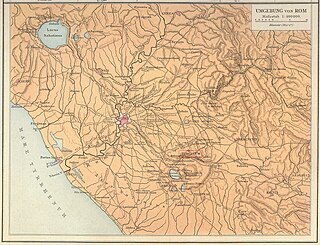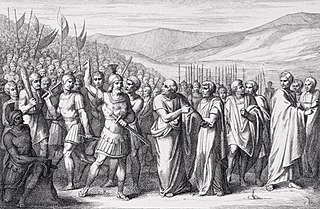Related Research Articles
Gaius Nautius Rutilus was consul of the Roman Republic in 475 BC and 458 BC.

The gens Furia,originally written Fusia,and sometimes found as Fouria on coins,was one of the most ancient and noble patrician houses at Rome. Its members held the highest offices of the state throughout the period of the Roman Republic. The first of the Furii to attain the consulship was Sextus Furius in 488 BC.
Quintus Fabius Vibulanus,son of Marcus Fabius Vibulanus,was consul of the Roman Republic and one of the second set of decemviri.

Lucius Minucius Esquilinus Augurinus was a Roman politician in the 5th century BC,consul in 458 BC,and decemvir in 450 BC.

The Battle of Corbio took place in 446 BC. General Titus Quinctius Capitolinus Barbatus and legatus Spurius Postumius Albus Regillensis led Roman troops to a victory over the Aequi tribes of north-east Latium and the Volsci tribes of southern Latium at the town of Corbio. The Romans had already defeated the Aequi in the Battle of Mount Algidus,so that the Battle of Corbio definitely marked the dominion of the Romans over this tribe.
The Roman–Latin wars were a series of wars fought between ancient Rome and the Latins,from the earliest stages of the history of Rome until the final subjugation of the Latins to Rome in the aftermath of the Latin War.
The Roman–Volscian wars were a series of wars fought between the Roman Republic and the Volsci,an ancient Italic people. Volscian migration into southern Latium led to conflict with that region's old inhabitants,the Latins under leadership of Rome,the region's dominant city-state. By the late 5th century BC,the Volsci were increasingly on the defensive and by the end of the Samnite Wars had been incorporated into the Roman Republic. The ancient historians devoted considerable space to Volscian wars in their accounts of the early Roman Republic,but the historical accuracy of much of this material has been questioned by modern historians.
Lucius Furius Medullinus,of the patrician gens Furia,was a politician and general of the Roman Republic who was consul twice and Consular Tribune seven times.
Titus Quinctius Capitolinus Barbatus was a Roman statesman and general who served as consul six times. Titus Quinctius was a member of the gens Quinctia,one of the oldest patrician families in Rome.
Marcus Geganius Macerinus was a Roman statesman who served as Consul in 447,443,and 437 BC,and as Censor in 435 BC.
The Roman-Aequian wars were a series of wars during the early expansion of ancient Rome in central Italy against their eastern neighbours,the Aequi.

The first secessio plebis was a significant event in ancient Roman political and social history that occurred between 495 and 493 BC. It involved a dispute between the patrician ruling class and the plebeian underclass,and was one of a number of secessions by the plebs and part of a broader political conflict known as the conflict of the orders.
Gaius Julius Iullus was a Roman statesman and member of the ancient patrician gens Julia. He was consular tribune in 408 and 405 BC,and censor in 393.
Servius Sulpicius Camerinus Cornutus was a Roman politician in the 5th century BC,consul in 461 BC and decemvir in 451 BC.
Lucius Furius Medullinus was a Roman politician active during the 5th century BC,and was consular tribune in 432,425,and 420 BC.
Spurius Furius Medullinus Fusus was a Roman politician in the 5th century BC,and was consul in 464 BC,and consul suffect in 453 BC.
Publius Furius Medullinus Fusus was a Roman politician during the 5th century BC,and was consul in 472 BC.
Titus Quinctius Poenus (Pennus) Cincinnatus was a consul of the Roman Republic in 431 and 428 BC and a consular tribune in 426 BC. He might have been consular tribune again in 420 BC.
Manius Aemilius Mamercinus was a three time consular tribune,in 405,403 and 401 and one-time consul,in 410 BC,of the Roman Republic.
Lucius Lucretius Tricipitinus Flavus was a Roman statesman and general who had a prominent career in the early 4th century BC,serving once as consul,and four times as consular tribune,as well as perhaps serving as Princeps senatus.